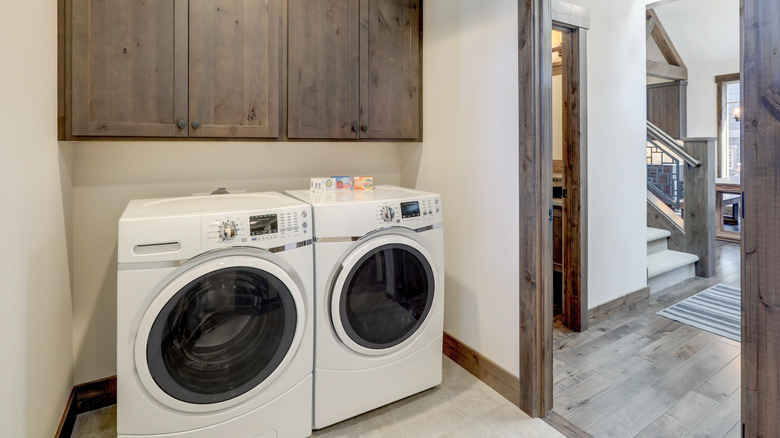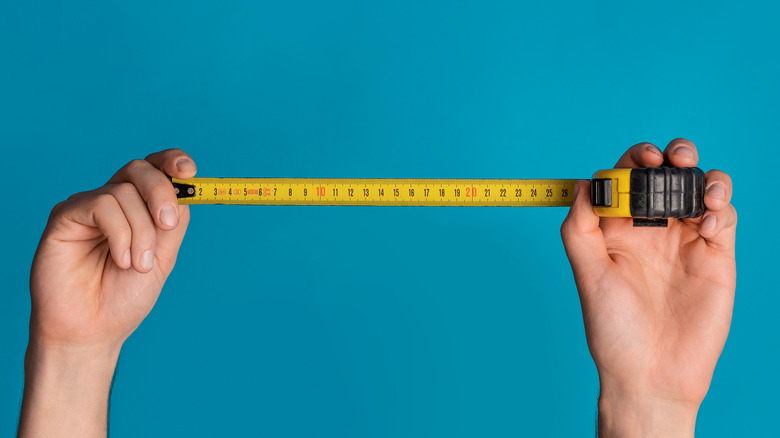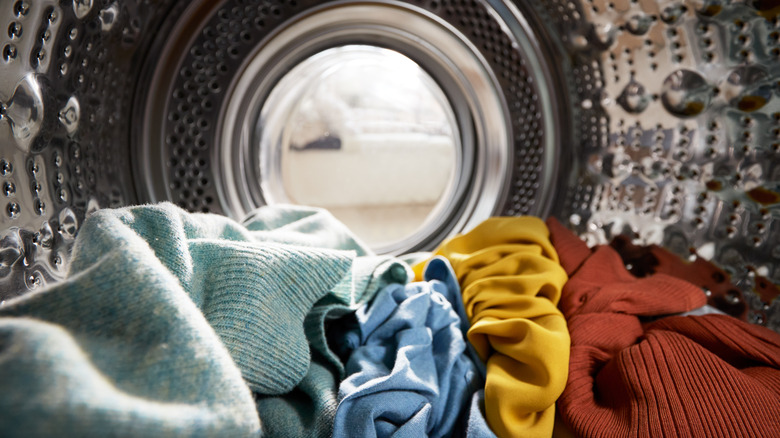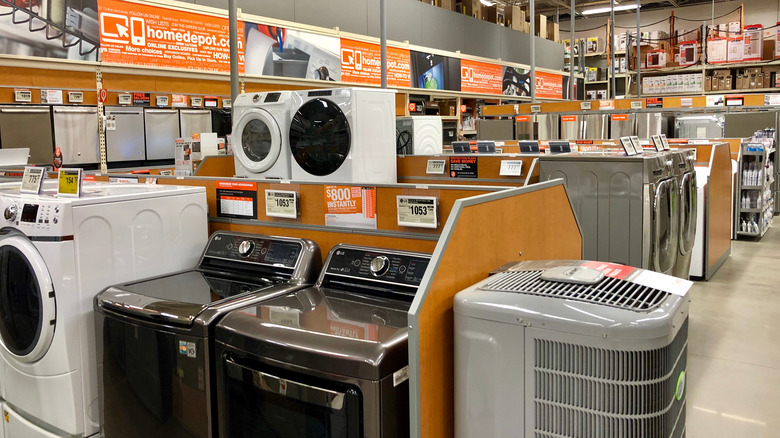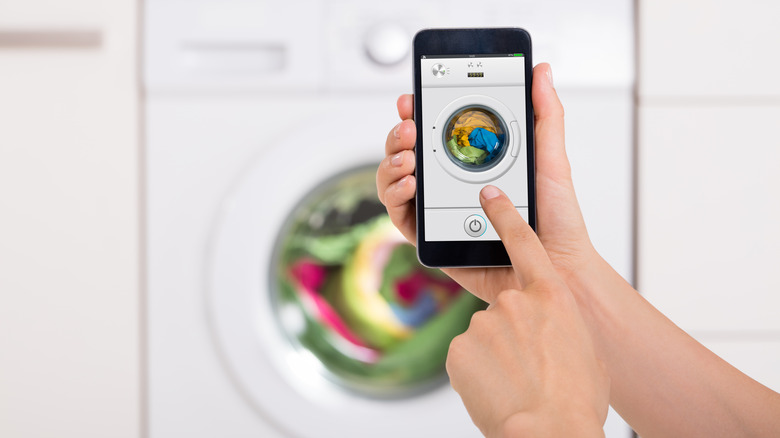Mistakes Everyone Makes When Buying A New Washer And Dryer
If it's time to upgrade your washer and dryer or you're moving to a new house or apartment that doesn't have these appliances already on site, you're probably diving into the research on the best washer and dryer to fit your needs and budget. Just like with most other appliances on the market these days, you won't lack options. Washers come in two different styles: front loading and top loading. Dryers typically only come in the front-loading style. There are also a variety of fancy features you can find in washers and dryers, such as digital time displays, autoload sensing to determine how much water to use in each load, automatic temperature control, a moisture sensor to prevent overdrying, and vent-blockage indicators (via Consumer Reports). You will need to determine which extra features are worth it to you as the price of the appliance tends to rise with the addition of bells and whistles.
Buying a washing machine and dryer is an investment that you'll benefit from for years to come, so it's not a decision to make lightly. If you're struggling to decide on which brand and model to purchase, scroll through the following mistakes most people make when purchasing a new washer and dryer and how to avoid making them.
Not measuring your space first
This might seem like an obvious one, but countless people make the mistake of not measuring the space where they will put their washer and dryer before heading to the appliance store. If you want the standard side-by-side layout, you'll need a space about 40" high x 56" wide x 31–34" deep (per Whirlpool). If you'd like to add a pedestal underneath your washer and dryer to avoid having to bend as much when loading and unloading laundry, an extra 15" of height should suffice.
Some spaces aren't conducive to the side-by-side pair and will require you to stack your machines. If this is the case, you'll need a space that's 80" high x 28" wide x 31-34" deep for full-size machines. A stacked laundry center, which is a washer and dryer that automatically comes stacked together, will require a bit less space at 74-76" high x 24-28" wide x 27-33" deep.
The above measurements provide a general rule of thumb for the amount of space you'll need for your new washer and dryer, but the size of the machines varies greatly. You can also find washers and dryers specifically designed for small spaces, which will reduce the amount of space you need to carve out. Regardless of which layout works best for you, it's always a good idea to measure first and carefully compare your measurements to those on the machines you're considering purchasing.
Not considering the energy efficiency rating
You can't avoid spending energy on washing and drying clothes, but the amount of energy you use will depend on the energy efficiency of the appliances you purchase. In 2020, Americans used an average of 10 billion kilowatt-hours washing laundry at home and around 60 billion kilowatt-hours drying it, according to Consumer Reports. According to Noah Horowitz, who is a senior scientist at the Natural Resources Defense Council, "Around 10 percent of a home's total electricity use goes to washing and drying clothes." That's quite a big chunk of electricity just to clean your clothes!
Additionally, the more energy you use, the more money you have to cough up. It's a good thing, then, that you can find plenty of highly efficient washing machines on the market these days. The ones you'll want to look out for have the lowest impact on the environment based on energy efficiency, water efficiency, reliability, and gentleness on clothes. Dryers have taken longer to become more energy efficient but if you have the extra money, look for a heat-pump dryer, which uses 20% to 60% less energy than conventional dryers. A dryer with a moisture sensor will also ensure a lower energetic output.
Choosing the wrong capacity
One important factor to consider when purchasing a washer and dryer is the amount of laundry you'll be doing per week and per load. This often depends on the size of your family. You'll want to think about the current number of family members in your household and whether you see this number growing in the future. Human members aren't the only ones to consider either — the number of pets you have will also determine the amount of laundry you'll be tackling in any given week.
Generally speaking, a regular-capacity washer will be able to wash about 12 to 16 pounds of laundry at one time, measuring about three to four cubic feet, as noted by My Move. If you think you'll need more washing capacity, you can find domestic washers that can handle up to 20 pounds of laundry, sometimes more. Larger-capacity washers measure at about 4.2 cubic feet. Naturally, the capacity of your dryer should correlate with that of your washer. If you are purchasing a washer and dryer from different sets or brands, make sure the dryer has double the capacity of the washer to ensure that clothes have enough room to expand as they dry and that hot air has room to circulate effectively.
Not paying attention to the manufacturer's warranty
You might be tempted to forgo the manufacturer's warranty when you purchase a washer and dryer, especially if you're getting a better deal without one. However, the warranty you choose will go a long way in ensuring you are protected as the consumer (via Don's Appliances). Not only is it a good idea to make sure the washer and dryer you choose come with a warranty, you'll also need to consider the coverage of said warranty. Most laundry brands cover any damages, parts, and labor for the first year after purchase. However, you can also find brands that offer a full five-year coverage or those that allow you to purchase an additional warranty period past the minimum. The latter category is referred to as an extended warranty, which is essentially insurance you purchase for your washer and dryer, according to Investopedia.
In some cases, the cost of an extended warranty will add a hefty extra couple of hundred dollars to the price of your new appliances, but if the worst were to happen within the first five years following your purchase, you will be incredibly grateful — appliance repairs and replacements do not come cheap. Whether you choose the standard manufacturer's warranty or the extended warranty, make sure you read the fine print in the contract to be certain of what you're getting.
Shelling out more than you need for smart technology
Smart washing machines and dryers are all the rage these days, and not for no reason. The technology allows its user to remotely start, stop, and monitor wash cycles from a smartphone app (per Lifewire). And it doesn't stop there — you can also use voice commands to control your washer and dryer as well as receive notifications when detergent levels get low or when it's time for regular maintenance, such as a self-cleaning cycle. The technology even gives you the option of downloading specialized wash cycles depending on the type of fabric you're washing.
It may be tempting to go for the best technology that exists on the market today, but smart technology comes at a cost. For example, the software often requires lengthy and frequent updates while network security is also an issue. As expected, smart washers and dryers have a price point far above their non-smart counterparts. If you're willing to pay the $800 to $2,000 per individual unit, keep in mind that any potential repairs will require a specialized technician and parts. The sensors in smart appliances will also add to repair expenses. While purchasing a smart washer and dryer is largely a matter of personal preference, make sure to consider the cost-benefit ratio and if it makes the most sense for your household rather than getting sucked in by the bells and whistles.
